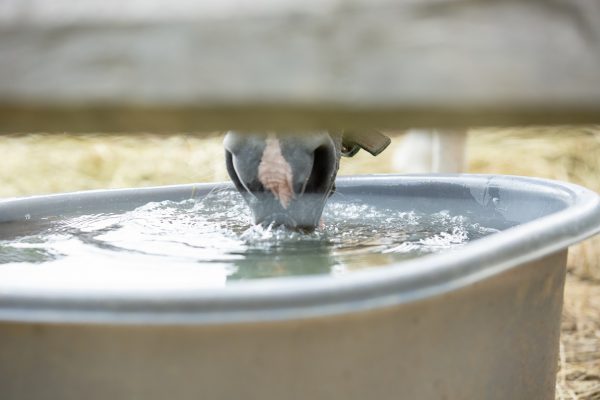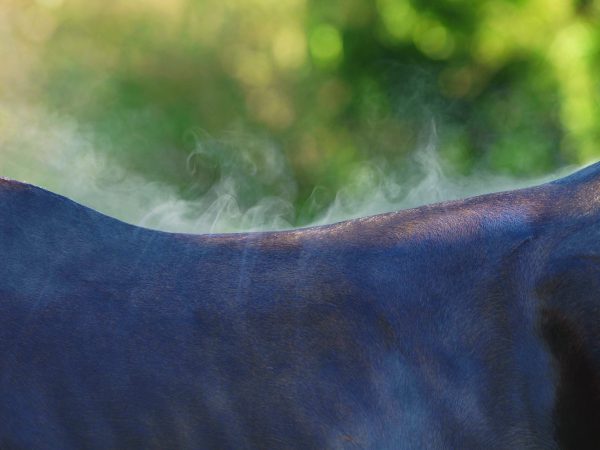Summer's Hottest Horse Owner Questions - Health Care Tips
You’ve got horse health questions, and we’ve got answers! We asked Dr. Lydia Gray to answer your most commonly asked questions about summer horse care so you can help your horse beat the heat this year.
Q: “How long should you wait to give your horse water after a workout?”
A: This is a great question, and I’m so glad that someone finally asked it! The idea that you have to wait to give your horse water after a workout is an old wives tale, and I’m not sure how it got started in the first place. According to modern research, there’s no reason to wait to give your horse water after a workout. In fact, it’s been found that if you wait to give your horse water, they’ll drink less than they would if you offered it right away. Horses tend to be thirstier in the first 15-30 minutes after they work, and offering them water immediately is a good way to help them rehydrate, cool down, and recover from their workout.

Q: “Is there any information on when is ‘too hot’ to ride? Also, if I’m concerned about my horse, how can I check if he’s overheating, and when should I call the vet?”
A: That’s great that your horse sweats a lot above 80 degrees! It means that he is acclimated to the environment and that his body has made adjustments—such as increasing the sweating rate and starting to sweat at a lower temperature—to adapt to the warmer weather. It’s also great that you notice at what temperature your horse’s cooling mechanisms really begin to kick in and that, even though he’s working and sweating, he still feels good.
To answer your first question, although a specific show, race, or other horse event may decide on an upper limit above which their activity may be modified or even cancelled, there’s really no hard and fast rule among the horse community about when it’s too hot to ride. One of the reasons is that temperature alone isn’t that great of an indicator of how well a particular horse may deal with the heat.
The problem with thermometers
Dry bulb thermometers are great for measuring the ambient air temperature, but unfortunately they don’t give you the whole picture. The next measurement that’s useful to know is the relative humidity, since horses (like humans) rely on sweating to keep their bodies cool but sweat doesn’t evaporate as well when there’s already moisture in the air. So the U.S. National Weather Service came up with “heat index” as a guide. But there are still more factors to take into account! The military devised the more comprehensive Wet-Bulb Globe Temperature Index, which combines temperature, humidity, wind, and solar radiation since air movement and sunshine can dramatically alter not only how hot it feels but also a body’s ability to release heat. My favorite though, and whose app I have on my phone, is AccuWeather’s “RealFeel.” These developers accounted for cloud cover, sun intensity, and even the angle of the sun in addition to the other components of temperature to come up with a number that is much more realistic. So I recommend you base your decision on one of these formulas that is based on more than just the absolute temperature.
Ways to be smart about the heat
Even armed with the latest, greatest technology though, there is still more to consider than just the environment.
It sounds like your horse already lives in the Midwest and so is used to warm, humid summers. If you had just shipped a horse from a cooler, drier region though, it normally takes about 21 days or three weeks for the body to acclimate to the new climate. Experts advise keeping the workload light as horses adjust.
In addition to getting used to a hotter, stickier environment, horses also have to get used to the exercise that is asked of them. If your horse is already fit going into summer, he’s more likely to tolerate the heat better. If not, again, keep the workload light.
Sweat (aka evaporation) is your horse’s primary means of cooling himself, but the other methods of heat dissipation—convection, radiation, and even conduction—play a role too. So find a cool breeze and seek shade when the heat seems overpowering. Cool water is your friend, whether it’s offering your horse a drink before or during exercise (that’s an old wives’ tale that hot horses colic when allowed to drink right after work) or hosing cool water on and scraping it off, as many times as necessary until the run-off isn’t warm.
Although you didn’t specifically ask about this, avoid hauling in a trailer when it’s extra toasty. With the sun rays warming things up and reduced air movement around the horse, it can get very warm inside a rig very quickly (think: dog in a car during the summer). If you must haul, go early in the morning or late in the evening—even overnight!—when it’s coolest and the sun’s rays are less intense.
Likewise, if you must ride, choose an early or late time so that the temperature, humidity, and sun haven’t built up to their strongest levels yet.
Don’t forget to add salt and other electrolytes to your horse’s feed or even a second bucket of water. Normal equine feedstuffs (hay, pasture, grain) don’t meet horses’ daily requirements for sodium. Plus when it’s hot and they’re sweating out a lot of sodium and chloride, horses can become even more deficient in these and other minerals. Since it’s been shown that most horses won’t lick a traditional salt block enough to meet their needs, top dress their feed with extra salt or a more comprehensive electrolyte mixture. It’s also okay to add these minerals to water, as long as you provide a second bucket of plain water for them to drink.
How to know if the heat is still too much
Despite your best efforts, your horse may still get overwhelmed by the extreme weather and not be able to keep up with cooling himself off. This is especially true for the non-sweating or anhidrotic horses (which is a separate blog). Keep an eye out for:
A depressed or dull attitude
Distressed behavior, such as whinnying or kicking
A reduced level of performance
Weakness or even a staggering gait
High heart rate
High respiratory rate (rapid, shallow breathing or panting)
Hopefully before any of these signs occur you recognize that your horse wasn’t dealing well with the heat and humidity and checked his rectal temperature. While the critical core temperature in the horse is unknown, readings above 107ºF are extremely serious. With the normal temperature of the horse being 99.5 to 100.5, anything above 102 or 103 may mean back off. If not, more serious signs may occur such as low blood volume and electrolyte abnormalities, then tying up, GI tract issues, kidney failure, nervous system consequences, and even collapse and death.
In such severe situations, you can help stop the horse’s core temp from continuing to climb by discontinuing work, repeatedly applying cool water (even cold water or ice water if available) all over the horse’s body and immediately scraping off and reapplying, getting a fan on the horse, moving him out of direct sunlight, and letting him drink. When the veterinarian arrives he or she may administer IV fluids and/or oral fluids via a stomach tube. Both sets of fluids will contain electrolytes to help restore the horse’s internal balance of these minerals which are lost in sweat. Additional therapy may be given depending on the horse’s signs.
To sum up (I know there was a lot of technical information in this answer), it sounds like you’re doing a great job paying attention to your horse and paying attention to the environment around you both. If you keep observing things closely and use common sense, you and your horse should be able to safely enjoy summer. And consider this: maybe on those really hot, humid days where there’s no wind, no cloud cover, and the sun is beating down, it’s time for an easy groundwork review, an extra thorough grooming session in a shaded aisle with a fan, or simply a nice, cool hosing off!

Q: “What’s the proper way to cool my horse down in the summer?”
A: The goal of “cooling out” a horse after a workout is to be able to put him away with normal vital signs (temperature, pulse, and respiration) and a dry coat. If you had a leisurely ride in the morning or evening when it was not as hot:
1. Take a relaxing walk at the end of your ride,
2. Dismount, loosen the girth, and hand walk,
3. Remove the saddle and brush or sponge off the sweaty areas,
4. Hand walk a bit more or put away if he’s fully recovered
For more intense rides, go through a proper warm down (active recovery), continuing to ride but at a lower intensity. This allows the horse’s heart and respiratory rates to come down gradually and for blood flow to slow and be redirected from the muscles to the rest of the body, taking waste products along with it. After steps 1 and 2 above, you may need to sponge or spray the horse with cool water to help lower his body temperature. Use a sweat scraper to immediately remove the water otherwise it acts as an insulating layer and keeps the heat it. Also, there’s no need for a cooler in the summer since you’re trying to release heat not hold it in.
If the combination of exercise, heat, and humidity has overheated your horse, he may need more aggressive cooling. While a gradual decrease in exercise intensity is still a good idea, as quickly as possible dismount and untack. Try to get your horse into a shady, breezy area. Begin sponging, hosing, or even bucketing cold water all over his body using the “spray, scrape, repeat” method, paying particular attention to the large blood vessels on the underside of the neck, belly, and on the inside of the legs. Consider adding ice or rubbing alcohol to the water to bring down his temperature faster. Experts agree cold water over the back will not cause cramps or tying up and that it’s actually a good idea to allow the horse to drink while he’s being cooled out.